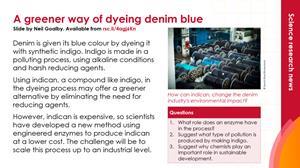Enzyme engineering and photolytic chemistry may provide a greener way to dye denim blue
-

Download this
Use this story and the accompanying summary slide for a real-world context when teaching lessons on using the Earth's resources with your 14–16 learners.
Download the story as MS Word or pdf and the summary slide as MS PowerPoint or pdf.
Enzymes could enable a greener and safer way to dye denim. The method may alleviate the environmental and health impacts linked to the manufacture of jeans, of which around four billion pairs are sold each year.
Denim is given its typical blue colour by dyeing it with synthetic indigo in an industrial process that uses alkaline conditions and harsh reducing agents. ‘Currently we have a lot of pollution going out from the dyeing mills,’ explains Ditte Hededam Welner, a biosustainability researcher at the Technical University of Denmark. This pollution often negatively impacts local agriculture and textile workers’ health, she adds.
A dyeing process that uses indican – a natural precursor of indigo – has previously been touted as a greener alternative to the status quo as its use would eliminate the need for harsh chemicals. The dyeing results are the same as for indigo, since indican is turned into indigo at the start of the dyeing process. However, indican’s use has so far been hindered by the high cost of producing the compound.

Utilising enzymes
Now, Ditte and her colleagues have developed an enzymatic process to produce indican that could make its use economically viable. The process an uses an engineered enzyme to convert indoxyl, an indigo precursor used in existing dye manufacturing, into indican. The final cost of its use is comparable to that of synthetic indigo.
Having established an economically-feasible manufacturing route to indican, the researchers assessed the sustainability of two potential methods for dyeing denim with this molecule. The first uses a natural enzyme to transform the indican into indigo; the second uses ultraviolet LEDs. A life cycle assessment found that the latter approach was more sustainable than current denim dyeing methods, but the enzymatic dyeing process had the lowest overall environmental impact.
The team states that adopting its process would require relatively few changes to existing dye factory set-ups. However, further work is needed before this technology is ready to be used in denim manufacture.
This article is adapted from Ada McVean’s in Chemistry World.
Nina Notman
Reference
G N Bidart et al, Nat. Commun., 2024, 15, 1489 (doi.org/10.1038/s41467-024-45749-3)
Download this
Summary slide with questions and the article for context when teaching 14–16 lessons on using the Earth’s resources: rsc.li/4ajyiWT
Downloads
A greener way of dyeing jeans summary slide
Presentation | PowerPoint, Size 0.53 mbA greener way of dyeing jeans summary slide
Presentation | PDF, Size 0.34 mbA greener way of dyeing jeans student sheet
Handout | Word, Size 1.17 mbA greener way of dyeing jeans student sheet
Handout | PDF, Size 0.26 mb














No comments yet